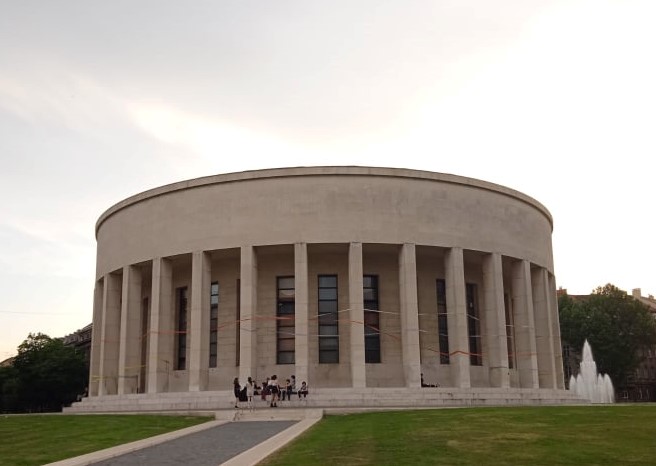
As part of the pre-program of Trnjanski kresovi to commemorate the liberation of Zagreb by the partisans on May 7th, the Zagreb Antifascist Network Zagreb organized Anti walks in cooperation with Documenta and researcher Tena Banjeglav.
Because citizens, and especially young people, know little about the events of the Second World War, Banjeglav emphasizes that it is important to mark the places of suffering and resistance.
“We need to constantly find new, innovative, and interesting ways to bring this history closer to young people. There’s no need for formal memorials or monuments. It would be enough to set up info-boards, which would located next to some important sites and would give information to all interested parties about what happened at those locations,” said Banjeglav, researcher at Documenta – Center for Dealing with the Past.
Artistic approaches are a good way of recognizing places of suffering and resistance. According to Banjeglav, this would bring attention to these sites as well as offer a dignified commemoration of the events which occurred there.
The concept of the memorial walk was created after Documenta published the guide “Zagreb in War, Resistance, Creativity and Memory” in March 2021. The guide includes over 50 locations in the city which are connected to wartime suffering as well as the anti-fascist resistance and authors who wrote about Zagreb. In addition, they looked for a way to bring the topics they deal with and places closer to citizens, especially young people.
“To date, we have held a dozen walks for the citizens of Zagreb, and many more for students of interested schools and colleges, and several walks for foreign guests. We are satisfied with the reaction to them so far, as well as the interest in them. They have proven to be a good format for more successful and easier communication about these difficult, sometimes controversial topics, as well as for exchanging experiences and information,” said Banjeglav. She added that the concept of memorial walks, such as this one in Zagreb, are an interesting way to provide citizens with new knowledge about locations in the city that they pass by every day.
For Banjeglav, the closeness that develops from visiting a place is very important, especially for young people, who are thus better able to remember the stories of events which occurred at the places around them.
“It is very important to deal with local history and engage young people and citizens in studying and researching the history of their city, neighborhood, or even street. I think that in this way, we further motivate them to learn about and come to terms with history, which has the greatest influence on them. I have heard many times from the people of Zagreb that it is interesting to be a tourist in your own city and to get to know and explore it further,” said Banjeglav.
Antifa walk through Zagreb
Balkan Diskurs youth correspondent Anja Zulić went on an Antifa walk through Zagreb, together with about twenty citizens.
“We gathered in front of the Zagreb Student Center (SC), today an unavoidable place in the daily lives of students. The area of today’s SC and the surrounding buildings such as the French pavilion, which serves as a gallery space, do not show that there was a transit camp for Jews, Serbs, communists, illegals, and other ‘unfit’ people in that location, in Zagreb’s dark past. From there, these people were transported to the first concentration camps in the then NDH (Independent State of Croatia). The area of SC and the former Zagreb Choir, that is, the Zagreb Fair, became a transit camp when the Ustasha came to power in 1941,” says Banjeglav at the beginning of the Antifa walk.

The location of the SC suited the Ustasha because of its size and connection with the railway. People were brought to the transit camp from Zagreb and other cities like Varaždin, Karlovac, and Koprivnica. They would spend four or five days there before being taken to other camps in Croatia. First was the Danica camp, near Koprivnica, which was the first to be established, then to the Gospić camp system (Gospić, Jadovno, Slana and Metajna on Pag), and later to Jasenovac and the local camps. Conditions in the transit camp, as in other camps, were awful. During their short stays in transit camps, people slept on the floors. They only had food if members of their family or community brought it to them. There Jewish community played a very important role, providing meals for fellow Jews interred in the camp. At night or early in the morning, people were brought to the camps in cattle cars. The transit camp operated at that location from May 1941 to August 1941 when it was closed, presumably due to its proximity to the city center. Residents of surrounding buildings could see what was happening, and those on the top floors of the buildings were prohibited from opening their windows. As a result, the camp was relocated to the former Kristalum textile factory in Zavrtnica, which was farther on the periphery then than it is today, where it operated until October 1941. After that, transit camps ceased to exist in Zagreb, but many prisons remained.
Failure to maintain existing memorials
We continue our walk to the Botanical Garden and Runjaninova Street, where today, a Health Center is located, which was formerly a home for Ustasha youth. There is a memorial in front of the entrance to the Health Center, as well as writing carved into the Botanical Garden walls. However, due to inadequate maintenance, it is impossible to read the writing, and there is little indication that these sites are symbols of anti-fascist resistance.
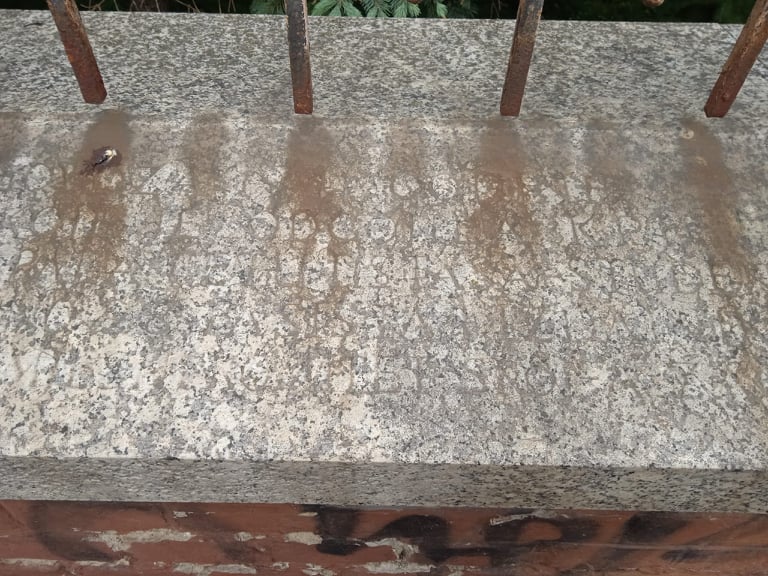
On August 4th, 1941, in response to the murder of a colleague who was a law student, twelve members of the League of Communist Youth of Yugoslavia (SKOJ) attacked the home for Ustasha youth, as its residents lined up at noon. The SKOJ managed to drop bombs as planned, but they had not anticipated a machine gun being mounted on the roof. Three of the 12 were arrested, while the others managed to escape. Nevertheless, this action, although unsuccessful, is considered one of the first significant operations of the Partisans. It was carried out in close proximity to the Nazi headquarters as well as the Ustasha police, who arrived on the scene quickly.
Another Zagreb location that testifies to the success of the resistance is the building of the Main Post Office at 13 Jurišićeva Street, which has not been in use since the earthquake in 2020. The communist attack in 1941 on the Main Post Office was the largest action carried out in Zagreb. The facility was used for all long-distance and interstate calls, and for that reason was bugged by the Gestapo authorities. During the operation, explosive devices were placed in the building and activated the next day, after the postal workers were informed of the impending attack to ensure they were able to leave the premises beforehand. After the operation, the Ustasha arrested many people and shot 50 Jews and partisans. Today, there are no markers at the post office commemorating this important historical event.
During the two-hour walk, we also stopped at the Central Train Station, a significant place in the context of the Second World War. Stations were important for both sides: trains transported prisoners, camp inmates, and those consigned to forced labor, but were also used by partisans and their sympathizers who later joined the ranks of the opposition. Beginning in 1941, the Ustasha authorities deported Jews and Serbs from the Central Station to camps in the Independent State of Croatia and Europe. The women and children rescued by Diana Budisavljević from numerous camps were first brought to the Central Station, from where they were sent to shelters for children and women of the Orthodox faith.
Transportation of the first detainees
Today, the black steam locomotive Katica can be seen at the Main Station, which, according to official information, is on display because it is one of the oldest in Croatia. It is less known that Katica, or a locomotive similar to it, transported the first detainees to Danica camp.
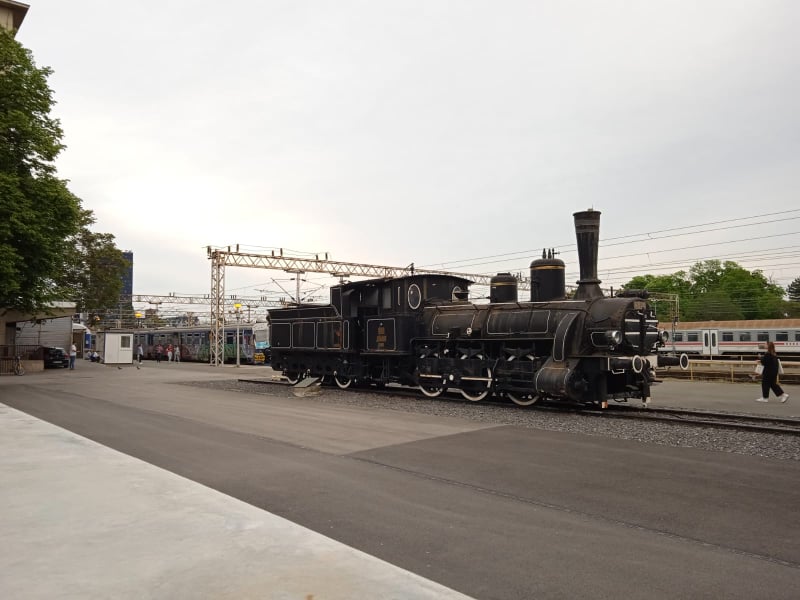
In 2022, a monument to the victims of the Holocaust and the Ustasha regime was erected at the Central Station, around which, as Banjeglav tells us, various controversies revolve. The monument consists of stacked suitcases representing the seized luggage of the victims.
“From the beginning, this monument was intended to commemorate the suffering of Jews, all six million killed in the world. Therefore, the artistic representation chosen is actually more a symbol of the suffering of the Jews, not very universalistic and inclusive. After victims’ associations, as well as anti-fascist and other organizations, protested the original idea in the course of long negotiations, we got this compromise solution – the victims of the Holocaust and the Ustasha regime,” said researcher of Documenta.
According to her, if you take a closer look at the inscription and read everything that is written on it, it still seems that the text is intended to commemorate only the Jews who were deported to Auschwitz in 1942.
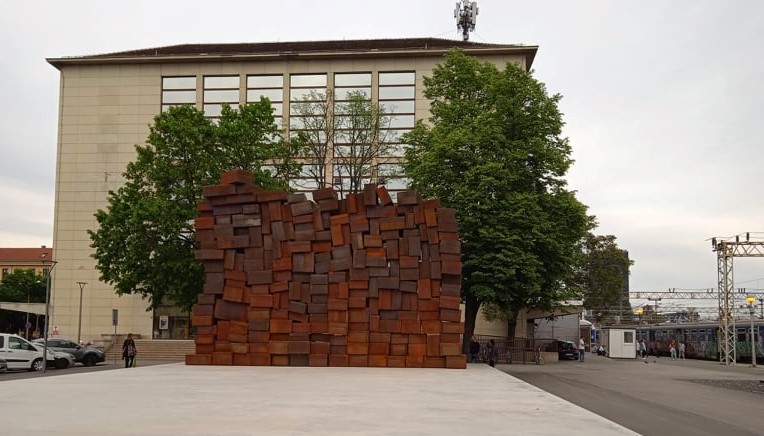
The memorial walk also took us to Praška Street, in the immediate vicinity of Ban Josip Jelačić Square, where the synagogue was located. The founding of the Independent State of Croatia was followed by the persecution of the Jewish community, culminating in the demolition of the synagogue. Today there is a parking lot in this area. The entire process of destroying the synagogue was photographed, filmed, and exhibited at one of the anti-Jewish exhibitions in the Independent State of Croatia.

To complete the memorial walk, we visited the location of today’s so-called “Mosque,” the Croatian Society of Fine Artists, located on the Square of Victims of Fascism, formerly Kulina Ban Square. Buildings in this area were once the sites of the former Gestapo prison and the headquarters of the Ustasha Surveillance Service. Although this building was a mosque for only a very short time and did not officially function as a mosque, the name has remained and continues to be used among the people of Zagreb.
A prison known for horrific torture
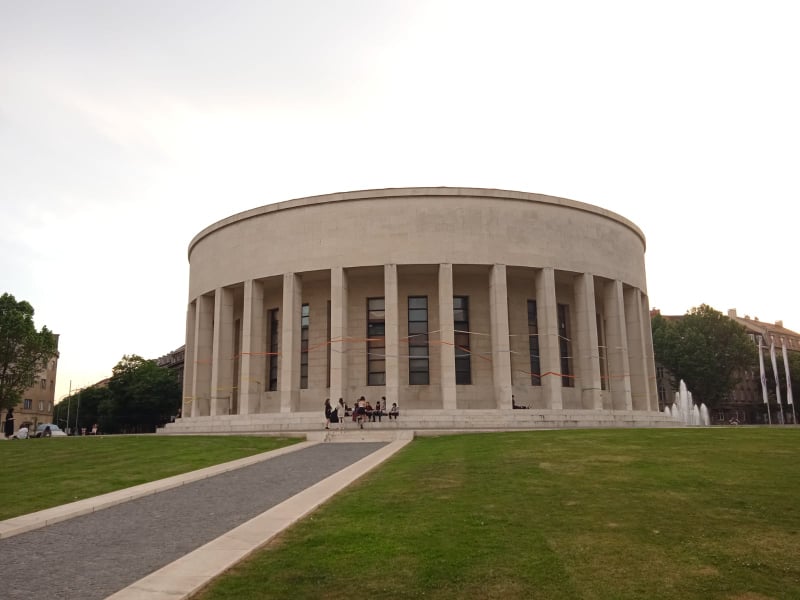
Right next to the “Mosque,” at 2 Zvonimirova Street, is the building where the Ustasha supervisory service and the secret police were based. The basement of the building was used as a prison, which is notorious for the horrific torture carried out there. The most famous prisoners of detained there were two sisters, Rajka and Zdenka Baković. Rajka was arrested for being a member of SKOJ, and Zdenka, for being a sympathizer. Both were brutally tortured in prison. Rajka was transported to the hospital where she died, and Zdenka jumped from the third floor of the building and died as a result of the impact.

Although this anti-fascist walk demonstrates that Zagreb has a rich anti-fascist history, Banjeglav explains that from her previous experience working and leading walks, citizens know little about Ustasha crimes, and even less about anti-fascist resistance.
“The situation is somewhat better with older citizens, those who were educated in Yugoslavia. For them, at least a part of that material was in the compulsory curriculum, so they know something. However, young people, those educated in the Republic of Croatia, know almost nothing, especially about topics and events related to anti-fascist resistance. While there is some talk about crimes and suffering in the Independent State of Croatia, at least by more motivated teachers, anti-fascism and resistance are very rarely topics in our schools. Even final year history students told me that they had not heard of many of the locations and didn’t know about many of the events we mentioned during the walks,” said Banjeglav.
Her impression, as she explained, is that in Croatia, anti-fascism is present only as part of the Constitution, but it is very unpopular to say that you are an anti-fascist or to deal with these topics. While other European countries, as she said, are proud of their anti-fascist history and often refer to it, in Croatia, it is almost a shame.






